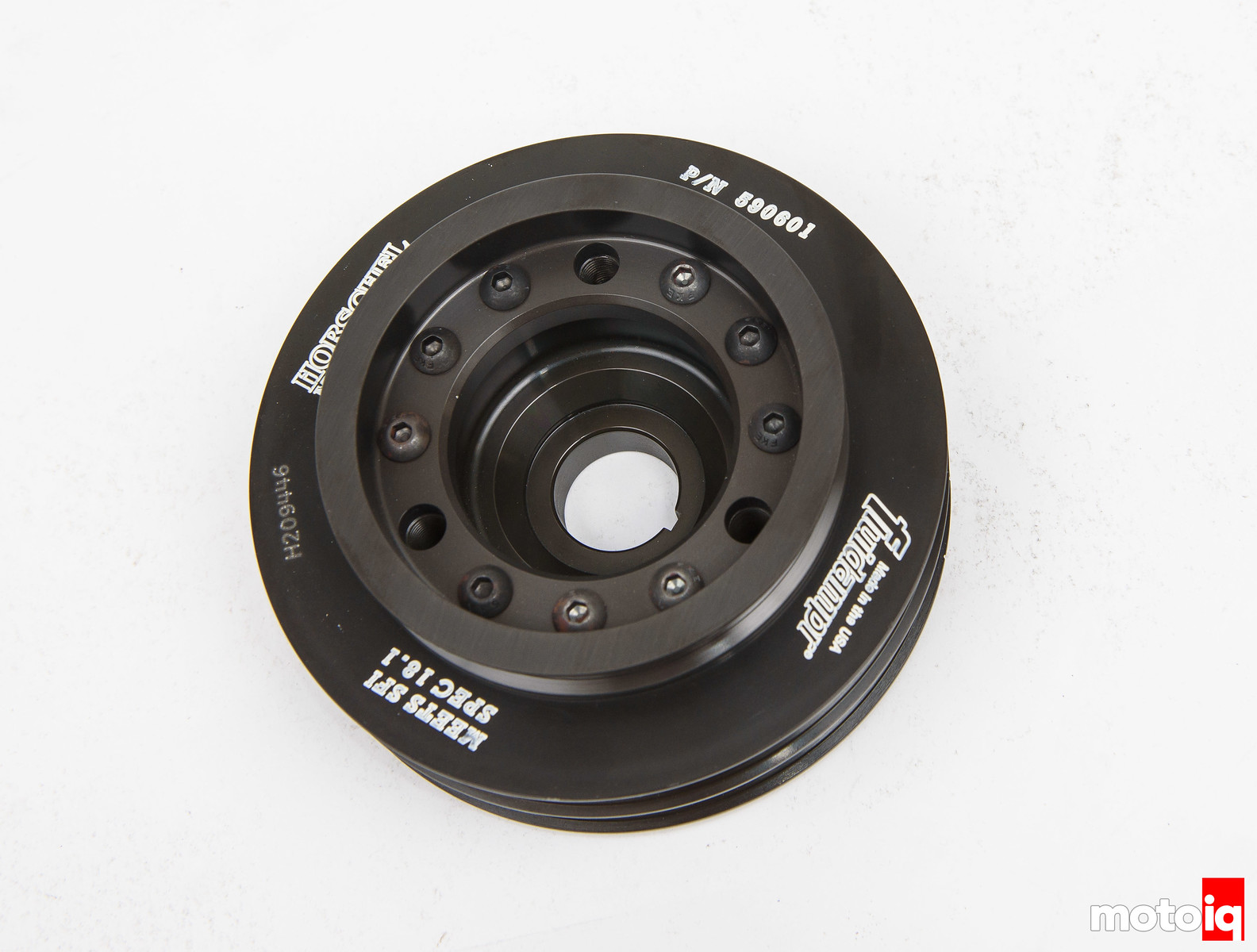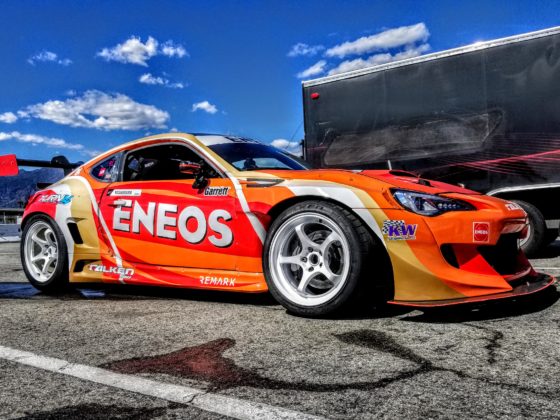
The Fluidampr balancer is now in place.

The belts and undertray were reinstalled.

Next, we dynoed the Fluidamper on our chassis dyno.

At first, we thought the damper made some amazing differences in power as blue is our baseline run. Then Jeff remembered that he had changed the cat on the car because it was failing smog. Whoops. We then had to remove the Fluidampr, reinstall the stock pulley and do a new baseline which was the black line.
The red line is a typical pull with the Fluidampr. As you can see, we got a little more power with the Fluidampr and more area under the curve. The car runs smoother and there are fewer dips in the power delivery. The smoothness in power delivery can be felt when driving the car and the pulls more freely to high RPM sounding less thrashy. We could really notice this when we drove the car on the Roval at Cal Speedway where you spend a long time at wide open throttle at high RPM. You can also feel less vibration and increased smoothness just driving the car around town.
We were surprised to see gains like this on the stock engine and with a modified engine that puts more stress on the engine’s internals as we plan in the future, the differences will be much more profound. So far we have used Fluidamprs on all of our serious high powered competition builds with great success.
When we go through our B18C to make serious NA power we will revisit this test again.




16 comments
How do you guys feel about the use of the single row OEM N1 crank pulley sold by Honda for the B series, which has been seen used on several Spoon cars with both B16B and B18C, and has no rubber ring at all?
Usually, for lower power NA engines with short stiff cranks, it is not an issue.
Actually for most flat plane cranks its not really that big of an issue if you don’t use a harmonic balancer. Harmonic balancers really show their worth on inherently unbalanced engines: Cross plane V8’s are the most common, but also straight fives like Volvo’s or VAG, or oddfire V6’s. Straight 3’s dont have that much benefit from it, Because of there length.
What you are seeing on the dyno is most likely down to resonance cancelling on the power end of the spectrum. But its still usefull for bearing life in general, even on straight 4’s or 6’s that don’t have heaps of power.
@ Mike Kojima: Have you run them on the flat fours? Because I recall you had some bearing issues? That might alleviate the problem somewhat. But what adds to the stress is solid mounting transmission and gearbox. The only remedy I have currently found is using balance shafts on flat 4’s with higher horsepower. or use a flat six of flat 4 with overlapping power strokes and be done with it….
P.s. I’ve sent email on writing via the email form on the site.
I ran it on my EJ25 and it made a huge difference in smoothness, to the point where the engine even sounded different! It did not result in any more power on the dyno although it has to help with engine stress. Your email got lost somehow. Can you email me directly at mike@motoiq.com?
Block flex is a mayor issue in the flat fours. In essence the same you are expiriencing with the V8 of Dai Yoshihara. In a sence both are caused by the conrods, and a bigger stroke doesn’t help one bit. Thats why I always use the biggest bore and the smallest stroke I can get away with.
We need to make instant torque and have a very wide powerband, hence the big stroke.
Oh, and sent it yesterday
Let me reply!
I got one of these for my FR-S, made a huge difference with my stiffened motor mounts. In terms of NVH, I at first thought the tachometer was lying – the engine was so much smoother, I couldn’t tell it was running.
I thought I read here that they’re developing one for new Miata, something so high-compression (13:1) can probably use some smoothing out. Have you heard anything about that?
We tested the Fluidampr on an FR-S and got good results. Check it out https://motoiq.com/fluidampr-the-independent-test/
Did you have any issue installing the pulley via Impact wrench? Due to your article, I have one on order for my track car (DC4). I’m slightly concerned as I’ve been reading various reports online about successfully installing via impact or needing the now that its discontinued $400 special tool
We didn’t.
LOOKING FOR THE BEST DAMPR FOR A STOCK 1957 270 CU IN GMC INLINE 6. THE STOCK ONE HAS COME APART AT THE RUBBER AND THESE ARE ALMOST IMPOSSIBLE TO FIND.
MAYBE TRY THE ONE IN THIS ARTICLE!
Is it worth it to install one of these harmonic balancers on a 4g63 engine from an
Evo 8/9?
We have it on ours.